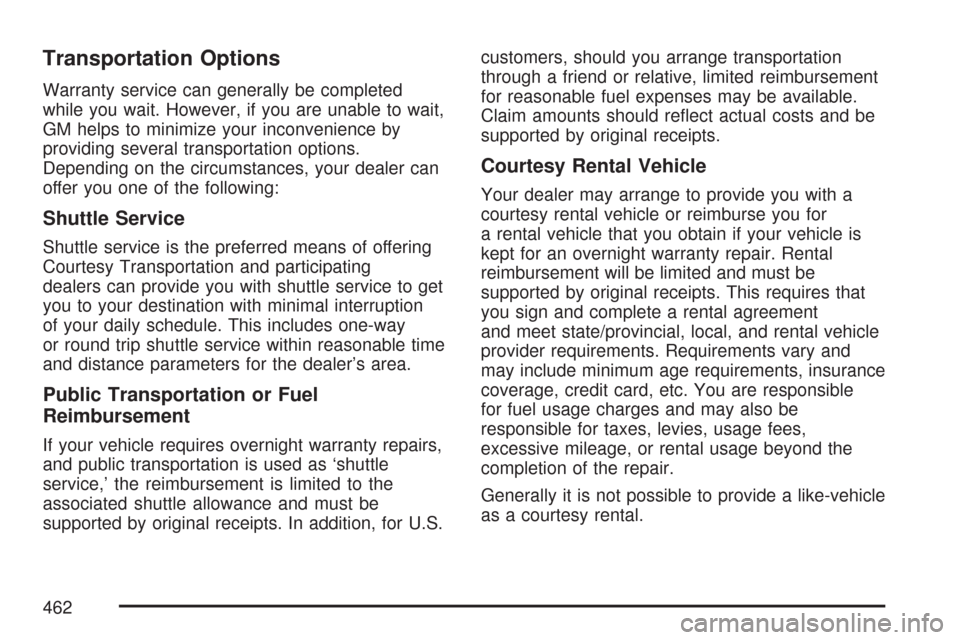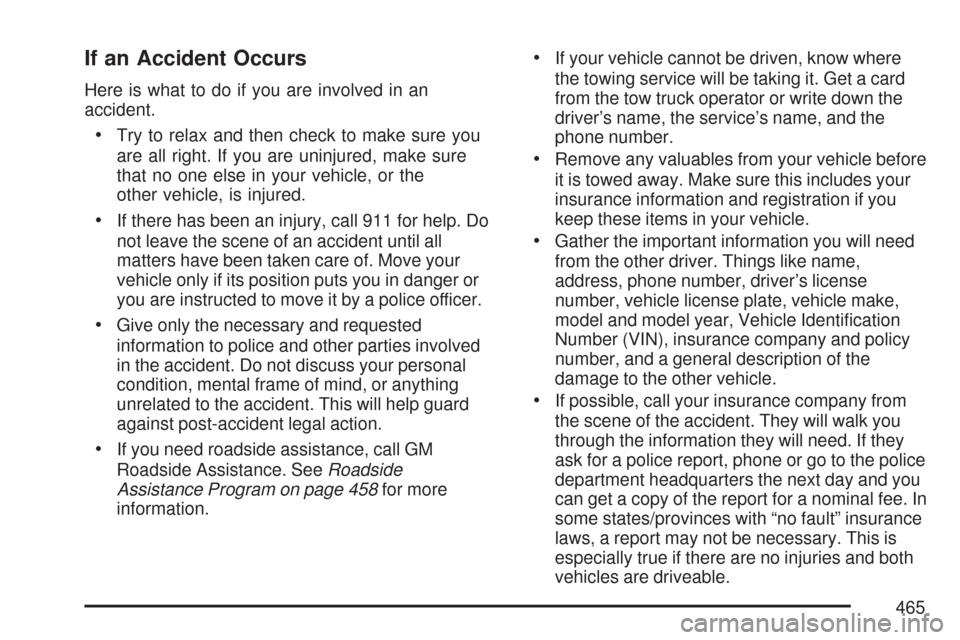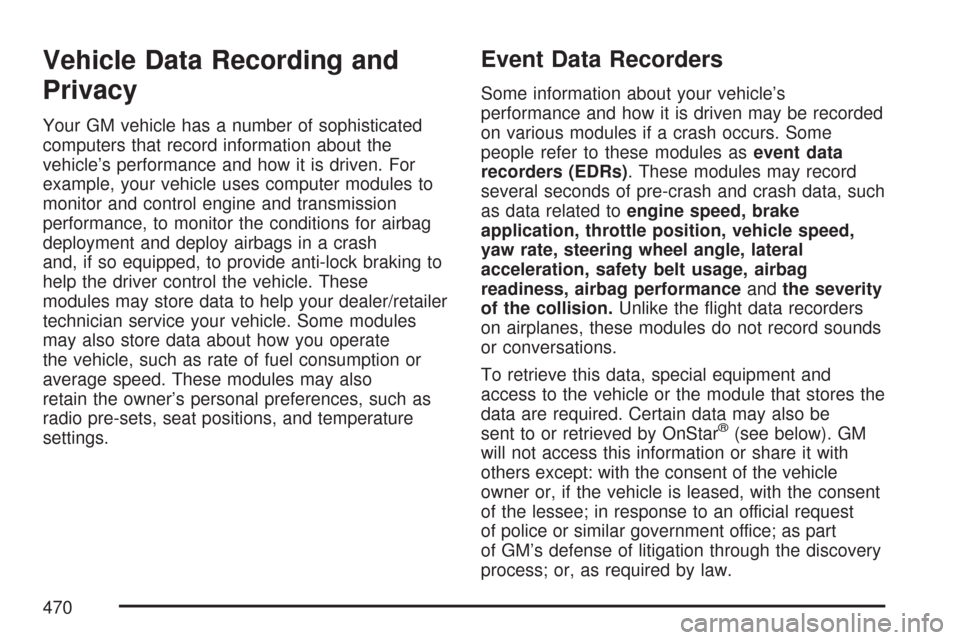Page 462 of 488

Transportation Options
Warranty service can generally be completed
while you wait. However, if you are unable to wait,
GM helps to minimize your inconvenience by
providing several transportation options.
Depending on the circumstances, your dealer can
offer you one of the following:
Shuttle Service
Shuttle service is the preferred means of offering
Courtesy Transportation and participating
dealers can provide you with shuttle service to get
you to your destination with minimal interruption
of your daily schedule. This includes one-way
or round trip shuttle service within reasonable time
and distance parameters for the dealer’s area.
Public Transportation or Fuel
Reimbursement
If your vehicle requires overnight warranty repairs,
and public transportation is used as ‘shuttle
service,’ the reimbursement is limited to the
associated shuttle allowance and must be
supported by original receipts. In addition, for U.S.customers, should you arrange transportation
through a friend or relative, limited reimbursement
for reasonable fuel expenses may be available.
Claim amounts should re�ect actual costs and be
supported by original receipts.
Courtesy Rental Vehicle
Your dealer may arrange to provide you with a
courtesy rental vehicle or reimburse you for
a rental vehicle that you obtain if your vehicle is
kept for an overnight warranty repair. Rental
reimbursement will be limited and must be
supported by original receipts. This requires that
you sign and complete a rental agreement
and meet state/provincial, local, and rental vehicle
provider requirements. Requirements vary and
may include minimum age requirements, insurance
coverage, credit card, etc. You are responsible
for fuel usage charges and may also be
responsible for taxes, levies, usage fees,
excessive mileage, or rental usage beyond the
completion of the repair.
Generally it is not possible to provide a like-vehicle
as a courtesy rental.
462
Page 465 of 488

If an Accident Occurs
Here is what to do if you are involved in an
accident.
Try to relax and then check to make sure you
are all right. If you are uninjured, make sure
that no one else in your vehicle, or the
other vehicle, is injured.
If there has been an injury, call 911 for help. Do
not leave the scene of an accident until all
matters have been taken care of. Move your
vehicle only if its position puts you in danger or
you are instructed to move it by a police officer.
Give only the necessary and requested
information to police and other parties involved
in the accident. Do not discuss your personal
condition, mental frame of mind, or anything
unrelated to the accident. This will help guard
against post-accident legal action.
If you need roadside assistance, call GM
Roadside Assistance. SeeRoadside
Assistance Program on page 458for more
information.
If your vehicle cannot be driven, know where
the towing service will be taking it. Get a card
from the tow truck operator or write down the
driver’s name, the service’s name, and the
phone number.
Remove any valuables from your vehicle before
it is towed away. Make sure this includes your
insurance information and registration if you
keep these items in your vehicle.
Gather the important information you will need
from the other driver. Things like name,
address, phone number, driver’s license
number, vehicle license plate, vehicle make,
model and model year, Vehicle Identi�cation
Number (VIN), insurance company and policy
number, and a general description of the
damage to the other vehicle.
If possible, call your insurance company from
the scene of the accident. They will walk you
through the information they will need. If they
ask for a police report, phone or go to the police
department headquarters the next day and you
can get a copy of the report for a nominal fee. In
some states/provinces with “no fault” insurance
laws, a report may not be necessary. This is
especially true if there are no injuries and both
vehicles are driveable.
465
Page 470 of 488

Vehicle Data Recording and
Privacy
Your GM vehicle has a number of sophisticated
computers that record information about the
vehicle’s performance and how it is driven. For
example, your vehicle uses computer modules to
monitor and control engine and transmission
performance, to monitor the conditions for airbag
deployment and deploy airbags in a crash
and, if so equipped, to provide anti-lock braking to
help the driver control the vehicle. These
modules may store data to help your dealer/retailer
technician service your vehicle. Some modules
may also store data about how you operate
the vehicle, such as rate of fuel consumption or
average speed. These modules may also
retain the owner’s personal preferences, such as
radio pre-sets, seat positions, and temperature
settings.
Event Data Recorders
Some information about your vehicle’s
performance and how it is driven may be recorded
on various modules if a crash occurs. Some
people refer to these modules asevent data
recorders (EDRs). These modules may record
several seconds of pre-crash and crash data, such
as data related toengine speed, brake
application, throttle position, vehicle speed,
yaw rate, steering wheel angle, lateral
acceleration, safety belt usage, airbag
readiness, airbag performanceandthe severity
of the collision.Unlike the �ight data recorders
on airplanes, these modules do not record sounds
or conversations.
To retrieve this data, special equipment and
access to the vehicle or the module that stores the
data are required. Certain data may also be
sent to or retrieved by OnStar
®(see below). GM
will not access this information or share it with
others except: with the consent of the vehicle
owner or, if the vehicle is leased, with the consent
of the lessee; in response to an official request
of police or similar government office; as part
of GM’s defense of litigation through the discovery
process; or, as required by law.
470